Dog Teeth Problems
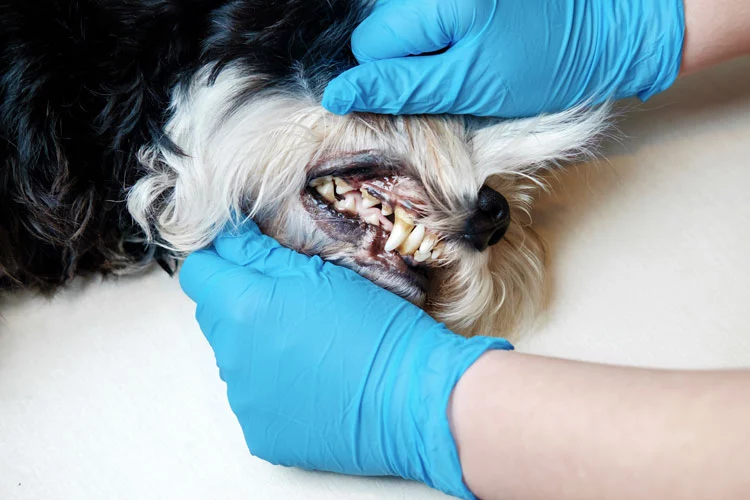
Much like humans, dogs can also develop oral diseases, including broken teeth and periodontal diseases. Dogs are five times more susceptible to dental problems than humans. In addition, the prevalence of periodontal diseases is at 80% among dogs over the age of 3.
The most common dental problem among dogs is bad breath. However, this is quite harmless when not accompanied by other serious dental diseases like periodontal disease. In the same line, cavities are also common among dogs and harmless when they are not a symptom of something serious.
This is because canines have an alkalizing mouth which promotes the buildup of plaques in their mouth. As bacteria multiply, their symptoms also do. As a result, it can lead to inflammation and tissue damage. This causes tooth loss and pain for your pup.
This article takes you through the various dog teeth problems often seen in your pet. Keep reading for signs, treatment, and prevention.
What is Dental Disease in Dogs?
Unlike humans, canines have little to no problems with tooth decay. But most dogs over three years old have dental disease. It comes in four stages, generally beginning with plaque and tartar in the mouth. This then leads to lightly inflamed gums, often called gingivitis.
If left untreated, they can progress into severe gum disease (periodontitis). And in due course, it may involve loss of bone and soft tissue around the affected teeth. In severe cases, it can affect other organs in your pet’s body and even organ failure.
Periodontal disease is one of the most common dental diseases seen in dogs. More than two-thirds of dogs aged three and older have the disease. Another common condition seen is fractured teeth. However, cavities are pretty rare and are present in only 10% of oral conditions.
When do Dogs Get Teeth Problems?
Dogs generally develop gingivitis at two years of age. However, it can get better with regular treatment. By the time they are three years of age, most dogs would have developed a dental disease. Gingivitis progresses to periodontal disease at about 4-6 years of age. When left untreated, it leads to bone loss.
Are Dental Problems Common in Dogs?
Dental disease is quite prevalent in canines. It is one of the most common ailments seen by vets. Unfortunately, only a few pets show outward signs of the disease. Therefore, it is up to the vet and the owner to spot this painful condition.
Of all dental diseases, periodontal disease is the most common infectious disease. It is a progressive, inflammatory disease that affects the supporting structures of the teeth. It is also the leading cause of early tooth loss in dogs.
Is the Dental Disease in Dogs Fatal?
Periodontal disease can cause more complications than just pain and loss of teeth. Untreated inflammation in pets can be a leading cause of liver, heart, and kidney diseases. In the end, they can untreated gum disease can destroy the bone so much so that even the slightest pressure can fracture your dog’s jaw.
Common Dog Teeth Problems
Dental complaints are the most common health problem for dogs. One of the most common issues is bad breath. Bad breath though harmless, does show signs of bad dental health. On the other hand, Cavities are uncommon and periodontal, or gum disease in canines is not.
Periodontal disease is one of the most commonly encountered health problems in dogs. The condition affects about 80% of pets by the age of three.
Teeth issues can harm the overall health and dog’s quality of life of your dog.
Plaque and Tartar Buildup
Plaque is an adhesive film on the inside of the tooth. It is a whitish substance consisting mainly of bacteria. The plaque creates a foul smell that increases with time unless you brush. When left unattended, they cause tooth decay and gum disease.
If not brushed within 24 – 48 hours, the plaque thickens into a hard substance called tartar. Also called calculus, tartar is a yellow or brown-colored substance that stays affixed to the teeth. At this point, they are not removed by brushing and will need to be scraped with a hard object. Once it reaches the gum line, it can irritate, leading to gum disease.
The primary signs dog owners will notice are poor quality breath, stained teeth, and red gum line. As it progresses, you may also find worsening breath and bleeding gums. Other contributing factors for gum disease are age, diet, breed, and genetics.
Periodontal Disease
Periodontal disease is a painful bacterial infection that affects the liver, heart, and kidneys when left untreated. As the name indicates, it affects the gums and the bones that surround the teeth. The dental disease is generally silent—there aren’t many apparent early signs and symptoms. However, once it advances, it causes untold pain for your dog, missing teeth, bone loss, swollen gums, and more.
Gingivitis/Gum Disease
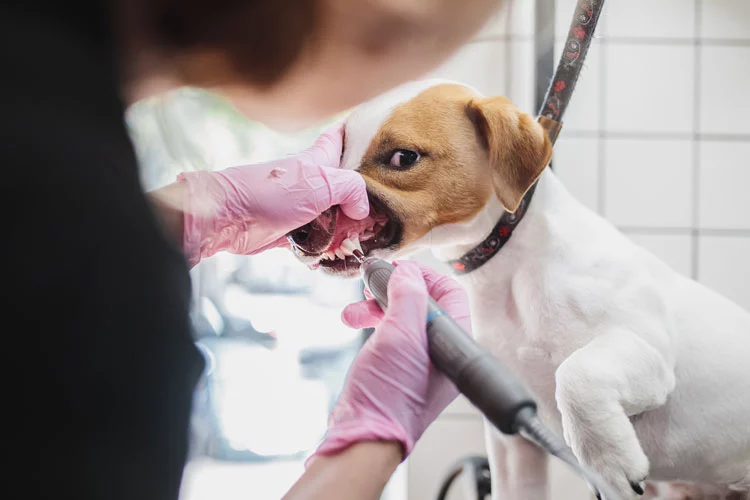
Gingivitis is the first stage of periodontal disease. The gums are inflamed due to the bacterial plaque, but the infection hasn’t reached the bones and ligaments. So in truth, the tartar that you see isn’t the reason for the infection.
When the hard tartar digs into the gums and gets under the gum line, it starts a vicious cycle of infection. The bacteria get trapped, which causes damage to the supporting tissues and the surrounding bone structure.
The inflamed gums become red or purple and swollen, bleeding on contact. Gingivitis at this stage is reversible. It is treated via a professional dental cleaning (under anesthesia). Following that, pet owners should follow proper oral hygiene, such as daily tooth brushing and dental cleaning.
Periodontitis
In the case of periodontitis, the infection is much more severe and affects the gum tissue, bones, and ligaments. As the vital supports of the teeth diminish, pockets develop around the roots of the teeth. This allows food, bacteria, and other debris to collect, causing infections.
The bacterial buildup in these pockets secretes a toxic substance causing further damage to the tissue. The resulting inflammation triggers the dog’s immune system, bringing in the white blood cells to fight the bacteria. However, in the process, the surrounding tissues and bones are also damaged. Over time teeth loosen and begin falling from the mouth.
Dentists treat periodontitis with a professional cleaning and regular treatment. In severe cases, your pet may require oral surgery to reach the root surface.
Tooth Root Abscess
In severe cases of periodontal disease, the bacteria reaches deep into the roots of the teeth. And then, it starts destroying the root depriving the tooth of its blood supply resulting in tissue destruction. This stimulates a response from the immune system, which floods the area with white blood cells (pus or abscess). At this stage, your pet would require a surgical intervention. The abscess affects the molars and presents itself as a swelling under the eye.
However, the tooth root abscess may also be linked to mouth trauma when dogs chew hard objects and injure their mouths. In addition, the infection causes the swelling and facial deformity, which can be pretty painful.
Tooth Fractures
Tooth fractures are common among dogs that are constant chewers. They happen when the dog chews on hard objects such as hard nylon chews, bones, antlers, and pig hooves. Your pet pooch should not chew on anything that doesn’t have a bit of a give.
The size of the chew also contributes to fractured teeth. A large chew toy will make the gum and tooth flex to an angle so that one side of the tooth is split. It is called slab fracture. Tooth fractures should be treated to save the tooth. If the pulp is exposed, root canal treatments and tooth extractions are the only options.
Retained Baby Teeth
All puppies have baby teeth which then fall out, making space for adult teeth. The adult teeth come in by the age of 6 months. In some cases, the puppies retain the baby teeth leading to overcrowding. Unfortunately, there is no way to treat retained baby teeth. However, dentists can remove them under anesthesia.
What are the Signs of Dental Problems in Dogs?
The signs of dental diseases in dogs are quite underrated. These cause your pooch untold pain and discomfort. Though these symptoms can sometimes be mistaken for older dogs, pet owners can see marked changes like:
- Bad breath
- Discolored teeth
- Plaque and tartar buildup
- Bleeding gums
- Swollen gums
- Loss of interest in chew toys
- Loss of appetite or difficulty eating
- Increased drooling
- Missing teeth
- Fatigue
- Pawing at the mouth
- Sneezing and nasal discharge (due to periodontitis in upper canine teeth)
Dog Breeds with Bad Teeth
Few dogs, especially the smaller ones, present a greater risk of developing periodontal diseases. However, as a pet parent, you need to be diligent with these breeds.
- Pug face dental problems like plaque and periodontal disease as a result of the short-muzzled bone structure. They also suffer from overcrowding of teeth.
- Chihuahua has a small mouth to host all 42 teeth. This makes them susceptible to periodontal disease.
- Yorkies often have retained baby teeth.
- Boxers and large breeds such as Great Danes and bulldogs suffer from gingival hyperplasia 0r thickening of gums.
- Collie suffers from an overbite, soft tissue trauma, and tooth-on-tooth wear.
- Dachshunds have a narrow muzzle hence making them susceptible to periodontal disease.
Why do Small Dogs have Teeth Problems?
Small breed dogs such as Chihuahuas, Pugs, and Yorkies are susceptible to dental disease. The consensus is the small heads which lead to overcrowding. There is not much space between the teeth, presenting more space for food particles to collect bacteria.
They also retain their baby teeth which again is a reason for overcrowding. In addition, other breeds such as pugs and Boston terriers have bite problems.
How do I Prevent Dental Disease in Dogs?
The most common risk factor for periodontal diseases in dogs is inadequate oral hygiene. The key to managing periodontal diseases is prevention. As long as their teeth remain clean, they will not harbor bacteria, and the gums will also stay healthy.
Dogs Do Not Show Signs of Teeth Pain
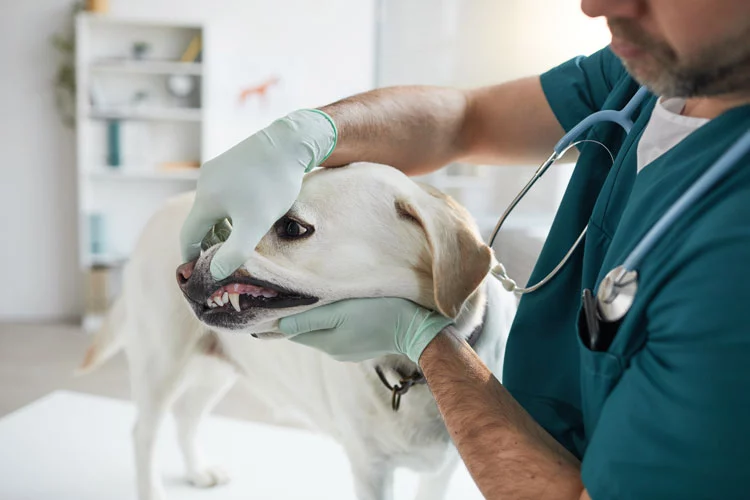
Less than 5% of dogs show outward pain in their teeth as a result of periodontal disease. This is because their animal instinct doesn’t allow them to show any pain. As a result, they have evolved to hide even the chronic pain.
Even with bleeding gum and cracked teeth, your pet would prefer to wag his tail rather than show you that he is sick. He will be the happy dog you know.
Examine Your Dog’s teeth daily
You’re unlikely to diagnose serious oral problems in a dog’s mouth. However, there are things worth looking for between all these vet cleanings. Look out for broken teeth, discolored teeth, and loose teeth. Other signs to look out for include:
- Blood on chew toys or water bowl
- Bad breath(within 1-2 months of cleaning)
- Swelling in or around the dog’s mouth
- Increased resistance to brushing
Know the Signs of Dental Diseases in Dogs
Stay vigilant for broken or discolorated teeth as well as if the teeth are turned. Too often, breeders, even vets, are looking at the signs that the pet is old. Unfortunately, all these signs of mouth cavities go wrong all too often. There are plenty of things that can happen in your dog’s mouth — but most of it can go unnoticed.
Keep an Eye on Their Oral Health
Taking care of your pet’s oral health is akin to taking care of your own. Here are some simple steps you can follow to ensure optimum health,
- Pet owners should do annual oral examinations, dental x-rays and dental cleaning every year under general anesthesia.
- Daily tooth brushing is the key to a healthy mouth. A pet toothpaste and pet toothbrush with a little bit of patience can help keep your pet healthy and happy.
- Give your pet safe chew toys to keep its mouth in top form. It helps slow down the progression of periodontal disease. For example, give them hard and rubber toys or thin rawhide bones.
- Feed your pet healthy foods suitable for his dietary needs. This includes food with additives to prevent plaque and dried food to scrub their teeth.
Conclusion
Veterinary dentistry is always available to help your dog with his periodontal disease. However, keep in mind that it is already advanced by the time you notice any signs of periodontal disease. So, the best treatment option is prevention.
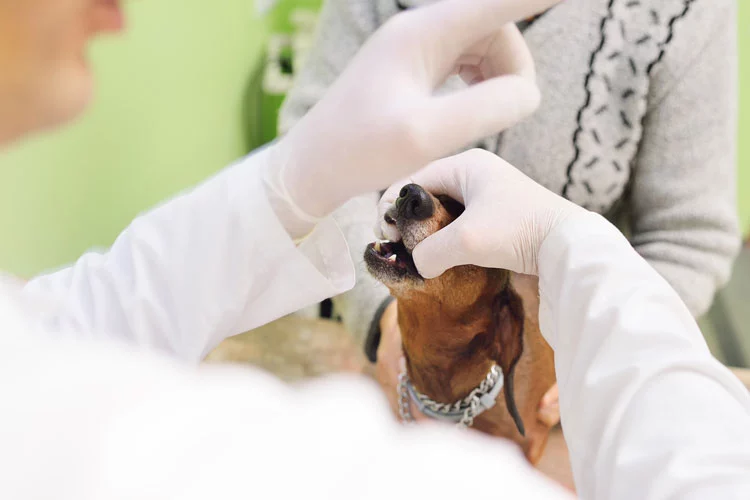
Daily tooth brushing is much more than clean teeth. It is the difference between a bundle of joy and a sick dog. It is also worth providing them with lots of opportunities to chew. And always feed your dog a proper diet. Finally, be sure you see your doctor during the day for regular checks. If you suspect gum damage talk to a vet first – brushing is sometimes ineffective.
If your dog is showing signs of periodontal disease, contact a vet. They will examine the nature of the disease and suggest a treatment plan.
In Tucson, Santa Cruz Pet Clinic is a world-renowned and trusted veterinarian that you desire for keeping up with your pet’s vaccinations at the proper time to ensure its health. Contact us today to schedule your pet’s vaccinations and check-ups.
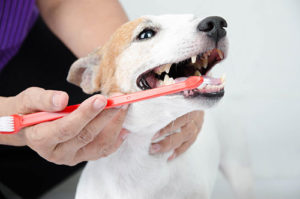 Most people do not realize how essential teeth cleaning is for dogs. There are many
Most people do not realize how essential teeth cleaning is for dogs. There are many  People Also Ask
People Also Ask Copyright © - SantaCruzPet.com
Copyright © - SantaCruzPet.com